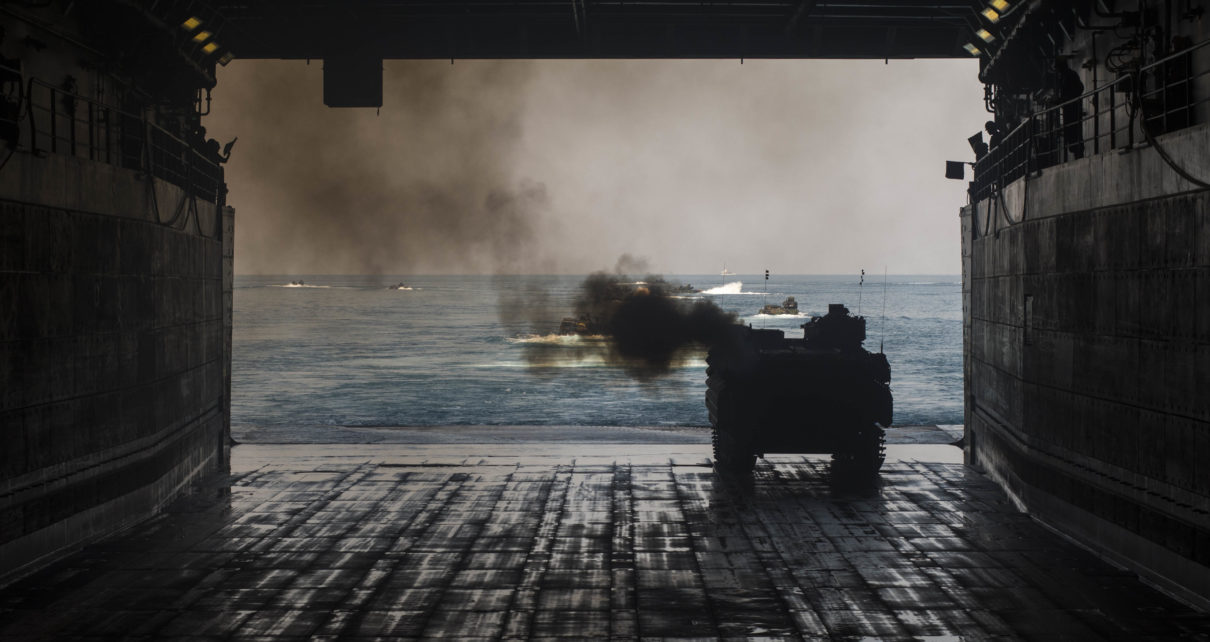In March of 2020, the US Marine Corps (USMC) released its Force Design 2030, a report outlining its vision for the coming decade. This policy document primarily focused on reforming the USMC’s force structure and capabilities to be prepared to engage in a possible future conflict in the Indo-Pacific region, namely with the People’s Republic of China (PRC). While including proposed reductions to the size of the USMC and its procurement of heavy armour units, Force Design 2030 also spotlighted the Corps’ interest in strengthening its information warfare capabilities to both counter disinformation and successfully execute tactical operations. Together, these shifts highlight the US’ renewed focus on the role of information as an operational domain within contemporary combat.
The end of the wars in Iraq and Afghanistan, which centred around counter-insurgency operations in largely land-locked countries, have allowed for the USMC to pivot once more towards its roots as a maneuverable, highly trained, naval-bound infantry force primarily focused on offensive actions. These roots are reflected in Force Design 2030, which envisions a smaller force whose capabilities, including more long-range precision weapons, are more geared towards the Indo-Pacific region rather than continuing to rely on combat assets such as tanks and unarmed drones.
Further, Force Design 2030 also highlights the USMC’s aim to compete in and win the “gray zone”, an area of operations between peace and open conflict that often encompasses the practice of information warfare. As detailed in Marine Corps Doctrinal Publication (MCDP) 8, the USMC’s strategy primarily focuses on instilling a “maneuver warfare” mindset regarding information warfare. This mindset, which builds on the USMC’s style of combat in other domains, centres on the use of maneuver warfare to allow for an inferior force to gain a superior position over its adversary. This position is maintained by creating and exploiting advantages within the information space rather than relying on a strategy of attrition and matching an adversary’s forces.
Moreover, MCDP 8 also calls for the USMC’s training to be overhauled to ensure that each Marine’s actions align with the broader strategic goals of a given operation. This training also extends to the officer corps, as MCDP 8 also highlights the demand for commanders to utilize official command information to preserve the USMC’s credibility while developing an understanding of the flow and effect of information on the battlespace. These tactical adjustments, in addition to the other changes outlined in Force Design 2030, capture a USMC preparing for the changing realities of the international system.
This shift in the force posture of the USMC highlights the US’ larger focus on the Indo-Pacific region and the PRC’s rise to near-peer status. The PRC has become increasingly focused on realizing its ambitions through a combination of a rapid military build-up and non-traditional techniques, such as information warfare and other “gray zone” maneuvers. The primary conduit of these latter tactics is China’s use of “Wolf Warrior Diplomacy,” along with other social media campaigns that targeted the US during the coronavirus pandemic. Further, the PRC also continues to launch disinformation campaigns targeting Taiwan, a critical point of friction between the two powers due to Beijing’s “One China” principle and Washington’s long-standing commitments to Taiwan’s defence. As such, the US’ focus on reforming the USMC, a rapid reaction force, to further integrate information warfare capabilities, along with its growing concerns over the stability of the region, highlights the significance of the challenge posed by China’s long-term aims to reshape the current balance of power in the Pacific.
More broadly, Force Design 2030 also represents the US’ increased willingness to adapt its style of warfare for an era of great power competition. While the USMC only represents a single component of the Navy, their broader importance to the US’ ability to project power overseas–a capability desired by the PRC–demonstrates the country’s commitment to adapting to a new form of combat against a novel adversary. This form of combat, as evidenced by both the current war in Ukraine and the recent war between Armenia and Azerbaijan, includes an increased emphasis on the mass psychological component of war along with the renewed importance of information to tactical success. As evidenced by Russia’s disinformation campaigns and the popular appeal of Ukrainian President Volodymyr Zelenskyy, contemporary warfare is reliant not only on battlefield victories but also largely on public opinion, which has incentivized Western countries to continue to provide advanced armaments and financial support to Ukraine and staved off its defeat.
Further, the most recent conflict in the Nagorno-Karabakh region also highlights the success of the integration between precision weapons and sophisticated information-gathering systems, once more demonstrating the increased value of information within tactical settings. These features of contemporary combat, the enhanced role of public opinion and intelligence, rather than massed fire and combined arms, illustrate the enduring role of information as a significant operational domain for the Corps.
Though slightly controversial due to its advocacy for a smaller, less armoured, and more regionally focused force, the USMC’s Force Design 2030 nevertheless highlights the US’ commitment to adapting to an international system that has not existed for nearly a generation. While the US’ relationship with the PRC has transformed from one based on the realpolitik balance of power to one intertwined with liberal internationalism to one now predicated on competition in the “grey zone,” the possibility of a “hot” war has remained remote. The USMC’s recent policy document partly upholds this status quo as evidenced by its concern over the effects of disinformation on the battlefield. However, in pivoting so explicitly to the Indo-Pacific region, the relationship between the US and the PRC may be on the cusp of a dramatic change. As repeatedly demonstrated by the history of great powers, no state invests in a military only not to use it.
Image copyright: “170217-N-GR361-041” by U.S. Pacific Fleet via Flickr. Licensed under CC BY-NC 2.0.
Disclaimer: Any views or opinions expressed in articles are solely those of the authors and do not necessarily represent the views of the NATO Association of Canada.




